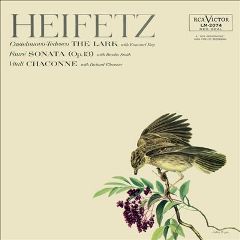Heifetz - Castelnuovo-Tedesco-Fauré-Vitale (1957)
Heifetz - Castelnuovo-Tedesco-Fauré-Vitale (1957)

1. Vitali – Chaconne 2. Castelnuovo-Tedesco - The Lark Faure - Sonata No. 1 , in A , Op. 13 3. I. Allegro molto 4. II. Andante 5. III. Allegro vivo 6. IV. Allegro quasi presto Jascha Heifetz – violin Richard Ellsasser – organ (1) Emanuel Vay – piano (2) Brooks Smith – piano (3-6)
It is not clear exactly how this demonic and exacting series of bravura variations came to be attributed to Italian Baroque composer Tommaso Antonio Vitali (1663-1745). There can be no doubt at all that Vitali had no hand whatever in the writing of this Chaconne, since scholars have found nothing even remotely similar to it within Vitali's catalog of authenticated works. Moreover, any suggestion that this might be a lost Vitali composition can be similarly dismissed, for there are not even any demonstrable stylistic affinities between the Chaconne and other pieces that have been reliably ascribed to Vitali, in particular a series of 12 sonatas for violin and keyboard. The Chaconne first came to the attention of violinists when it was published as Vitali's work in a collection of pieces (Die Hoch Schule des Violinspiels) edited by the virtuoso and close friend of Mendelssohn, Ferdinand David, and issued in 1867. What is known is that the stern and majestic G minor theme was extensively revised and made progressively more difficult in each successive variation, transforming it into a gripping tour de force of staggering technical difficulty. For this reason, it was selected as the opening work on the bill when Jascha Heifetz presented his debut recital at Carnegie Hall, and indeed, one could hardly imagine a more impressive curtain-raiser. It is just as unclear whether David (who was highly regarded for his advocacy of Baroque music, largely ignored throughout the nineteenth century) wrote the Chaconne himself or possibly assembled it from a variety of motifs by obscure figures of the high Italian Baroque. But this convoluted puzzle doesn't end there. Another violin virtuoso, Frenchman Léopold Charlier, produced an alternative -- and if possible, even more taxing -- edition in 1911. Charlier not only enhanced the technical demands of the violin part, but also made significant improvements and added new harmonizations to the piano part, whilst reordering the sequence of the variations so that they become progressively more complex as this astounding piece unfolds. --- Michael Jameson, Rovi
In Florence in 1926 Castelnuovo-Tedesco met Heifetz, who said he had been stimulated by Spalding to play the piece entitled Capitan Fracassa and asked to have the concerto sent to him. After hearing Heifetz perform the concerto in Paris the following year, within ten days Castelnuovo-Tedesco wrote The Lark, dedicated ‘To Heifetz, the lark that sings at heaven’s gate’. --- Tully Potter, naxos.com
Fauré contributed two violin sonatas, separated by 40 years, of which this one is by far the best known, and may be said to have initiated the line. Florent Schmitt correctly wrote that its appearance "marks a red-letter day in the history of chamber music." Each movement has at least one achingly lovely lyrical theme. The passionate first theme is shared by both instruments (piano and violin are treated as partners throughout the work, rather than as soloist and accompaniment). The second movement, Andante, is reticent, almost shy, in character, with a fine melody for violin. The Scherzo is light-hearted in its outer sections, but lyricism returns in its central section, or "trio." Finally, the last movement is dramatic and emotional, yet even here there is an interlude with a lovely romantic theme. --- Joseph Stevenson,Rovi
download (mp3 @320 kbs):
uploaded yandex 4shared mega mediafire solidfiles zalivalka cloudmailru oboom








